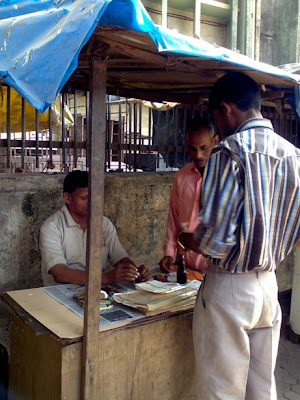- By Deepa Krishnan
.
Ever since the wholesale market moved from Byculla to Vashi, I've been wanting to go there. On a recent trip to New Bombay, my friend Satyen took me to see what is officially called The Mumbai Agricultural Produce Market.
.
Exterior view - one small section of the market.
Even before we went in, I realised I was going to see a big market, but as we kept driving along, I realised that this market was literally endless! Nothing had prepared me for the sheer scale of what I saw.
The agricultural produce market covers all of 170 acres (hah! and I had originally believed I could explore it on foot!). There are a staggering 3700 godowns, 1500 commercial blocks, 4 large auction halls, 2 giant warehouses, and 5 large wholesale market yards. Apart from this, there are big processing centres - a vapour heat treatment plant, ripening facilities, cold storage facilities, an export facilitation centre and so on.
To me, it was like seeing a vast new exciting trading town, where trucks trundled in with every conceivable type of agricultural produce from the country. I could see hundreds of farmers, in their white Gandhi-topis. There were many women too, in their traditional Maharashtrian sarees. There were literally thousands of workers, transporting bags of produce. It was only much later, when I saw the website of the market committee, that I discovered that this is Asia's largest regulated market for agricultural produce.
As we drove around, Satyen pointed out to me that there is not one market, but five different markets. Market I is dedicated to spices and condiments, sugar, jaggery and dry fruits. Market II is where trading in foodgrains (rice, wheat) and pulses takes place. Then there's the popular "kanda-batata markit" - The Onion and Potato Market, which was the earliest to be set up. Other than these, there are two more markets, the Fruit Market and the Vegetable Market. For a "city girl" like me, it was like getting a glimpse into an alien world.
After the first few minutes of driving around, I gave up trying to grasp it all, and just enjoyed the atmosphere of the place. At the vegetable and fruit markets, I couldn't resist getting out of the car and clicking a few photographs.

Gujarati housewives at the wholesale vegetable market
The first thing I noticed were some enterprising housewives, who had come to buy their weekly store of vegetables at wholesale prices. Satyen explained that some housing societies had formed groups, so that they could come here to this market and purchase in bulk for their needs.
Weighing scales on truck
I walked around to the backside of a truck to see what was happening. Jackfruit was being unloaded from the truck. Before the unloading, it was being weighed in a basket. This is a regulated market - that means that the weighing instruments are provided by the market, and there are fixed rates for the people doing the unloading.
 Green chillies inside the vegetable market
Green chillies inside the vegetable market The chillies come from Andhra Pradesh and Karnataka. These men were waiting with their stock of chillies, looking for buyers.
.
 Old man in 'Gandhi-topi' examining brinjals from Bangalore.
Old man in 'Gandhi-topi' examining brinjals from Bangalore. I think he was a retail shopkeeper who had come to the market to buy his stock, because behind him were all the other vegetables that he had purchased, tied in plastic bags.
 Several women were in the market, haggling over prices.
Several women were in the market, haggling over prices. Some of them looked like local shop-keepers to me, while others looked like they were buying for their own use.

Mango crates amidst hay in the fruit market
This man had purchased two crates of mangoes, and paid someone to carry it to his truck. The 'hamaali' or labour rate per 'peti' (box) is Rs 2.5.

Mini-truck leaving the market
This smaller truck was loaded with gunny sacks of various vegetables, and was leaving the market to go into the city. The 'hamaali' for one gunny sack is Rs 5.
 Vegetable seller leaving the market with small amount of stock..
Vegetable seller leaving the market with small amount of stock..
 Mid-sized trader leaving with his stock .
Mid-sized trader leaving with his stock .Over 12000 tonnes of agri-commodities arrive daily into this market. The produce is sold by auction and the prices are noted and managed by the Mumbai Agricultural Produce Market Committee. It is the committee's responsibility to ensure that sales do not take place below the minimum price fixed by the government. They are also responsible for ensuring fair measurement and weighing, and fair charges for labour.
.
I wanted to spend more time, talking to people - traders, labourers, shopkeepers, and buyers...I wanted to understand how the pricing system worked. But it was nearing noon and the sun was getting fierce. My driver Mariappan had cleverly retreated to the local canteen (that's him in the white shirt and black trousers, standing in the shade drining chai).
.
So I finally called it a day, and sank gratefully into the coolness of the airconditioned car. As I dropped Satyen back home, I said to him, "I'm coming back again to Vashi! There's so much still to see!"
Want to come with me?
 My first impression of the interior.
My first impression of the interior. Mom in the rust colour saree. She's helping the lady in green fill a form in English.
Mom in the rust colour saree. She's helping the lady in green fill a form in English. The green is for inside the country, and the red is for international.
The green is for inside the country, and the red is for international. Exterior of Sion Post Office.
Exterior of Sion Post Office. Mr. Moustache - the grand old man outside Post Office!
Mr. Moustache - the grand old man outside Post Office!



















































